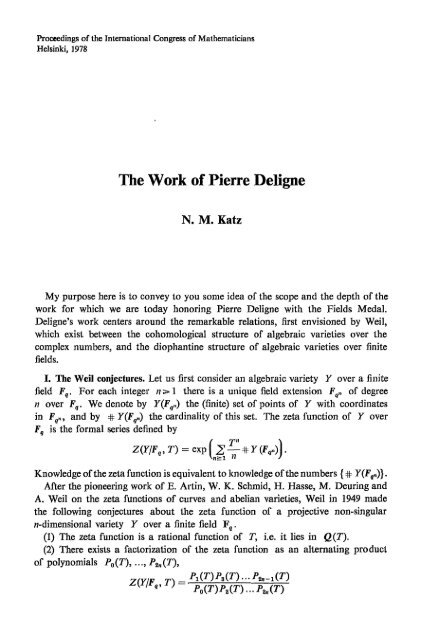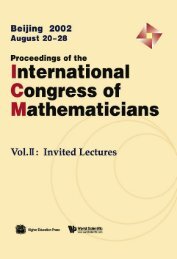The Work of Pierre Deligne - International Mathematical Union
The Work of Pierre Deligne - International Mathematical Union
The Work of Pierre Deligne - International Mathematical Union
Create successful ePaper yourself
Turn your PDF publications into a flip-book with our unique Google optimized e-Paper software.
Proceedings <strong>of</strong> the <strong>International</strong> Congress <strong>of</strong> Mathematicians<br />
Helsinki, 1978<br />
<strong>The</strong> <strong>Work</strong> <strong>of</strong> <strong>Pierre</strong> <strong>Deligne</strong><br />
N. M. Katz<br />
My purpose here is to convey to you some idea <strong>of</strong> the scope and the depth <strong>of</strong> the<br />
work for which we are today honoring <strong>Pierre</strong> <strong>Deligne</strong> with the Fields Medal.<br />
<strong>Deligne</strong>'s work centers around the remarkable relations, first envisioned by Weil,<br />
which exist between the cohomological structure <strong>of</strong> algebraic varieties over the<br />
complex numbers, and the diophantine structure <strong>of</strong> algebraic varieties over finite<br />
fields.<br />
I. <strong>The</strong> Weil conjectures. Let us first consider an algebraic variety Y over a finite<br />
field F q . For each integer n^l there is a unique field extension F qil <strong>of</strong> degree<br />
n over F q . We denote by Y(F qn ) the (finite) set <strong>of</strong> points <strong>of</strong> Y with coordinates<br />
in F qli , and by # Y(F qn ) the cardinality <strong>of</strong> this set. <strong>The</strong> zeta function <strong>of</strong> Y over<br />
F g is the formal series defined by<br />
Z(Y/F q , D = exp f 2 v * Y ( F À •<br />
Knowledge <strong>of</strong> the zeta function is equivalent to knowledge <strong>of</strong> the numbers { # Y(F qn )}.<br />
After the pioneering work <strong>of</strong> E. Artin, W. K. Schmid, H. Hasse, M. Deuring and<br />
A. Weil on the zeta functions <strong>of</strong> curves and abelian varieties, Weil in 1949 made<br />
the following conjectures about the zeta function <strong>of</strong> a projective non-singular<br />
w-dimensional variety Y over a finite field ¥ q .<br />
(1) <strong>The</strong> zeta function is a rational function <strong>of</strong> T, i.e. it lies in Q(T).<br />
(2) <strong>The</strong>re exists a factorization <strong>of</strong> the zeta function as an alternating product<br />
<strong>of</strong> polynomials P 0 (T) 9 ..., P 2H (T) 9<br />
P 1 (T)P>(T)...P*- 1 (T)<br />
Z(Y/F q ,T)=r<br />
P 0 (T)P 2 (T)...P 2tl (T)
48 N. M. Katz<br />
<strong>of</strong> the form<br />
Pi(T)=<br />
nV-aijT),<br />
such that the map oL*^q n loL carries the a u bijectively to the a 2n -i,j-<br />
(3) <strong>The</strong> polynomials P t (T) lie in Z[T] 9 and their reciprocal roots
<strong>The</strong> <strong>Work</strong> <strong>of</strong> <strong>Pierre</strong> <strong>Deligne</strong> 49<br />
medean considerations into the /-adic theory without first knowing the rationality<br />
<strong>of</strong> the c<strong>of</strong>ficients <strong>of</strong> the P itl <br />
Let me now try to indicate the brilliant synthesis <strong>of</strong> ideas involved in <strong>Deligne</strong>'s<br />
solution <strong>of</strong> these problems.<br />
Initially, he tries to prove à priori that the P ul have rational coefficients independent<br />
<strong>of</strong> /. <strong>The</strong> idea is to proceed by induction on the dimension <strong>of</strong> Y. If Y is<br />
77-dimensional, then Poincaré duality and the fact that the zeta function is itself<br />
rational and independent <strong>of</strong> / reduce us to treating the polynomials P Ui for<br />
i
50 N. M. Katz<br />
cohomological theory <strong>of</strong> such L-functions, the Kazdan-Margoulis theorem, and the<br />
classical invariant theory <strong>of</strong> the symplectic group!<br />
Once he has this à priori estimate for the variable parts <strong>of</strong> the P„- ltl <strong>of</strong> the<br />
hyperplane sections Z,, a Leray spectral sequence argument shows that in the<br />
P„ tl for Y itself, all the reciprocal zeroes are algebraic integers which, together<br />
with all their conjugates, satisfy the apparently too weak estimate<br />
Kj\ < 0 (n+1)/2 (instead <strong>of</strong> q n %<br />
But this estimate is valid for Y <strong>of</strong> any even dimension n. <strong>The</strong> actual Riemann<br />
hypothesis for any projective smooth variety X follows by applying this estimate<br />
to all the even cartesian powers <strong>of</strong> X.<br />
II. Consequences for number theory. That there are many spectacular consequences<br />
for number theory comes as no surprise. Let us indicate a few <strong>of</strong> them.<br />
(1) Estimation <strong>of</strong> # Y(F q ) when Y has a "simple" cohomological structure.<br />
For example, if Y is a smooth «-dimensional hypersurface <strong>of</strong> degree d, we get<br />
i*r W -o + , + ... +rt i-= f-^r«-y,<br />
(2) Estimates for exponential sums in several variables, e,g<br />
(a) if / is a polynomial over F p in n variables <strong>of</strong> degree d prime to /, whose<br />
part <strong>of</strong> highest degree defines a nonsingular projective hypersurface, then<br />
2 expßjp/fe,..., x n ))\ ^ (rf-l)V /2 ;<br />
*iEF p<br />
(b) "multiple Kloosterman sums":<br />
v<br />
p<br />
x t £F* V P \<br />
x l~- x n)J\<br />
(3) <strong>The</strong> Ramanujan-Petersson conjecture. Already in 1968 <strong>Deligne</strong> had combined<br />
techniques <strong>of</strong> /-adic cohomology and the arithmetic moduli <strong>of</strong> elliptic curves with<br />
earlier ideas <strong>of</strong> Kuga, Sato, Shimura and Ihara to reduce this conjecture to the Weil<br />
conjectures. Thus if 2 a ( n^n * s ^e<br />
^-expansion <strong>of</strong> a normalized (a(l) = l) cusp<br />
form on r x (N) <strong>of</strong> weight k^2 which is a simultaneous eigenfunction <strong>of</strong> all Hecke<br />
operators, then<br />
\a(p)\ < 2p (ft - l)/2 for all primes p\N.<br />
III. Cohomological consequences; weights. As Grothendieck foresaw in the 1960s<br />
with his "yoga <strong>of</strong> weights", the truth <strong>of</strong> the Weil conjectures for varieties over<br />
finite fields would have important consequences for the cohomological structure <strong>of</strong><br />
varieties over the complex numbers. <strong>The</strong> idea is that any reasonable algebro-geometric<br />
situation over C is actually defined over a subring <strong>of</strong> C which, as a ring,<br />
is finitely generated over Z. Reducing modulo a maximal ideal m <strong>of</strong> this ring,
<strong>The</strong> <strong>Work</strong> <strong>of</strong> <strong>Pierre</strong> <strong>Deligne</strong> 51<br />
we find a situation over a finite field,and the corresponding Frobenius endomorphism<br />
F(m) operating on this situation. This Frobenius operates by functoriality on the<br />
/-adic cohomology, which is none other than the singular cohomology, with Q r<br />
coefficients, <strong>of</strong> our original situation over C. This natural operation <strong>of</strong> Frobenius<br />
imposes a previously unsuspected structure on the cohomology <strong>of</strong> complex algebraic<br />
varieties, the so-called "weight filtration", or filtration by the magnitude <strong>of</strong> the<br />
eigenvalues <strong>of</strong> Frobenius.<br />
In a remarkable tour de force in the late 1960's and early 1970's, <strong>Deligne</strong> developed,<br />
independently <strong>of</strong> the Weil conjectures, a complete theory <strong>of</strong> the weight filtration<br />
<strong>of</strong> complex algebraic varieties, by making systematic use <strong>of</strong> Hironaka's resolution <strong>of</strong><br />
singularities, <strong>of</strong> the notion <strong>of</strong> differential forms with "logarithmic poles" (i.e. products<br />
<strong>of</strong> fi///'s), and <strong>of</strong> his own earlier work on cohomological descent. <strong>The</strong> resulting<br />
theory, which <strong>Deligne</strong> named "mixed Hodge theory", should be seen as a farreaching<br />
generalization <strong>of</strong> the classical theory <strong>of</strong> "differentials <strong>of</strong> the second kind"<br />
on algebraic varieties, as well as <strong>of</strong> "usual" Hodge theory.<br />
Consider, for example, a smooth affine variety U over C. By one <strong>of</strong> Hironaka's<br />
fundamental results, we can find a projective smooth variety X and a collection <strong>of</strong><br />
smooth divisors Dj in X which cross tran sver sally, suchthat U^X—UDi. <strong>Deligne</strong><br />
shows that the Leray spectral sequence, in rational cohomology, <strong>of</strong> the inclusion<br />
map Ua+X 9 degenerates at £ 3 , and that the filtration it defines on the cohomology<br />
<strong>of</strong> U is independent <strong>of</strong> the choice <strong>of</strong> the compactification. This is the desired weight<br />
filtration; its smallest filtrant is the image <strong>of</strong> H m (X) in H*(U) 9 i.e. the space <strong>of</strong><br />
"differentials <strong>of</strong> the second kind on £/".<br />
One <strong>of</strong> the many applications <strong>of</strong> this theory is to the global monodromy <strong>of</strong> families<br />
<strong>of</strong> projective smooth varieties. Given a projective smooth map X-+ S <strong>of</strong> smooth<br />
complex varieties, and a point s£S 9 the fundamental group n^S, s) acts on each<br />
<strong>of</strong> the cohomology groups H l (X S9 C) <strong>of</strong> the fibre X s . <strong>Deligne</strong> shows that these<br />
representations are all completely reducible, and that each <strong>of</strong> their isotypical components,<br />
especially the space <strong>of</strong> invariants, is stable under the Hodge decomposition<br />
into (p 9 ^-components.<br />
By means <strong>of</strong> an extremely ingenious and difficult argument drawing upon Grothendieck's<br />
cohomological theory <strong>of</strong> L-functions and the ideas <strong>of</strong> the Hadamard-de la<br />
Vallée Poussin pro<strong>of</strong> <strong>of</strong> the prime number theorem, <strong>Deligne</strong> later established an<br />
/-adic analogue <strong>of</strong> this theorem <strong>of</strong> complete reducibility for /-adic "local systems"<br />
in characteristic /; over open subsets <strong>of</strong> the projective /-line P 1 , provided that all<br />
<strong>of</strong> the "fibres" <strong>of</strong> the local system satisfy the Riemann Hypothesis (with a fixed<br />
power <strong>of</strong> |/#). Once he had proven the Riemann Hypothesis for varieties over<br />
finite fields,he could apply this theorem to the local system coming from a Lefschetz<br />
pencil on a projective smooth variety over a finite field. <strong>The</strong> resulting complete<br />
reducibility is easily seen to imply the hard Lefschetz theorem. This theorem, previously<br />
known only over C, and there by Hodge's theory <strong>of</strong> harmonic integrals,<br />
is thus established, in all characteristics as a consequence <strong>of</strong> the Weil conjectures.
52 N. M. Katz: <strong>The</strong> <strong>Work</strong> <strong>of</strong> <strong>Pierre</strong> <strong>Deligne</strong><br />
Other outgrowths <strong>of</strong> <strong>Deligne</strong>'s work on weights include his theory <strong>of</strong> differential<br />
equations with regular singular points on smooth complex varieties <strong>of</strong> arbitrary<br />
dimension, which yields a new solution <strong>of</strong> Hubert's 21st problem, and his affirmative<br />
solution <strong>of</strong> the "local invariant cycle problem" in the local monodromy theory <strong>of</strong><br />
families <strong>of</strong> projective smooth varieties.<br />
Still another application <strong>of</strong> "weights" is to homotopy theory. <strong>Deligne</strong>, Griffiths,<br />
Morgan and Sullivan jointly apply mixed Hodge theory to prove that the homotopy<br />
theory ((g)Q) <strong>of</strong> a projective smooth complex variety is a "formal consequence"<br />
<strong>of</strong> its cohomology,<br />
IV. Other work. We have passed over in silence a considerable body <strong>of</strong> <strong>Deligne</strong>'s<br />
work, which alone would be sufficient to mark him as a truly exceptional mathematician;<br />
duality in coherent cohomology, moduli <strong>of</strong> curves (jointly with Mumford),<br />
arithmetic moduli (jointly with Rapoport), the Ramanujan-Petersson conjecture<br />
for forms <strong>of</strong> weight one (jointly with Serre), the Macdonald conjecture (jointly with<br />
Lusztig), local "roots numbers", /-adic L-functions (jointly with Ribet), motivic<br />
L-functions, "Hodge cycles" on abelian varieties, and much more.<br />
I hope that I have conveyed to you some sense, not only <strong>of</strong> <strong>Deligne</strong>'s accomplishments,<br />
but also <strong>of</strong> the combination <strong>of</strong> incredible technical power, brilliant clarity,<br />
and sheer mathematical daring which so characterizes his work.<br />
PRINCETON UNIVERSITY<br />
PRINCETON, N.J. 08540, U.S.A.















